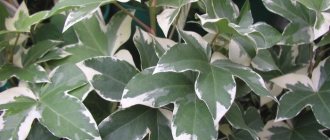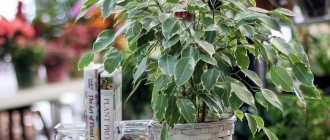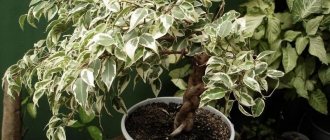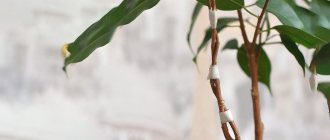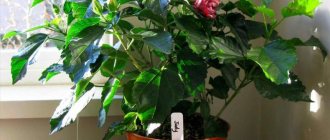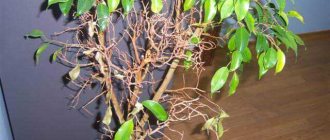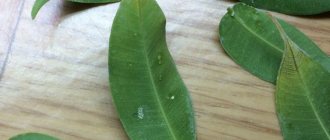Ficus benjamina is one of the most popular indoor plants among modern amateur gardeners. It is relatively unpretentious. But in order for a flower to feel good and delight its owners with its spectacular appearance, you need to know some secrets of its maintenance. You should also pay great attention to the prevention of diseases and parents, to which the plant is very sensitive.
Varieties and varieties
There are many varieties of this flower, bred by domestic and foreign breeders. As a rule, they differ in the shape and color of the leaves, as well as the height of the adult plant and life expectancy (which can be quite long with proper care). Most often, domestic gardeners grow the following species at home:
- with dark green leaves;
- with variegated leaves (mosaic pattern);
- with slightly curled leaves.
Not only the appearance, but also the characteristics of care depend on the variety. Some species are more vulnerable to diseases and pests, while others are more resistant; the same can be said about the requirements for fertilizing and soil moisture.
With green leaves
These plants have smooth, dark green, ovoid, slightly glossy leaves. The most popular varieties among domestic amateur gardeners are:
- Monique;
- Exotic;
- Anastasia;
- Dunetti.
They are quite sensitive to lack of moisture, but have good immunity to diseases and common pests.
Nicole
This is one of the shortest varieties, so it is recommended to grow it in small apartments where a tall plant with a branched crown will not fit. The leaves are dark green, glossy on the outside, their length reaches up to 6 cm. The leaves have an oblong ovoid shape, curve along the vein and are smooth at the edges.
Daniel
It is an evergreen plant that belongs to the mulberry family. The homeland of this variety is the Australian tropics. At home it grows up to two meters, and in nature – up to 30 meters inclusive. The glossy oval leaves are smooth along the edges and in the middle, their length reaches 5 cm. In a young plant they are light green, but darken with age.
Monique
This ficus grows quickly, the shoots are long and thin; If young growth is not trimmed in time, it bends and breaks. The lower leaves fall down in beautiful waves. The leaves are 5–6 cm long, glossy, dark green, with a pronounced convex vein in the middle.
Exotic
The height of an adult plant is 1.5 meters. The leaves are wavy at the edges and straight inside, dark green. A correctly formed crown has a pronounced spherical shape.
Anastasia
This is the most light-loving variety; it quickly withers in the shade. If the lighting is sufficient, the flower can grow up to 1.8 m, and the leaves reach 7 cm in length; if there is little light, the leaves become smaller and dry out. The dense, fleshy, dark green leaves are glossy and elliptical in shape.
Dunetti
The height of the plant is up to 3 m; under the right conditions, ficus often blooms, but the flowers are small and pale. The plant has a dense crown that requires regular pruning. The leaves are 5 cm long, fleshy, dense, light green.
Moklame
This variety has many aerial roots, the leaves are 6 cm long and have the shape of an ellipse. The height of an adult plant can reach 3 m if there is enough light in the room. The bark is gray and loose. The plant requires feeding.
Variegated (variegated)
These varieties look especially beautiful. Their leaves seem to be decorated with multi-colored mosaics that form intricate patterns. The most popular varieties:
- Twilight;
- Nina;
- Safari;
- De Gantelle.
These varieties require regular feeding. The pattern on the leaves may lose its original appearance due to fungal and viral infections, diseases and pests. To restore the shape of the leaves, the flower must be sprayed regularly.
Starlight
This is a plant of the mulberry family, the foliage has a beautiful mosaic marbled coloring that resembles marble. White spots stand out effectively against a dark green background. This is a unique color. However, this variety has a drawback - slow growth, only 10 cm per year.
Safari
Compact, low-growing variety, suitable for small apartments. The leaves are 4 cm long, separated by a vein, have a slightly curved shape, and marbled yellow-white spots are randomly scattered on them. In low light, the foliage turns yellow and growth slows down. For normal development, an additional source of lighting is required - a lamp.
Nina
Compact miniature variety, leaf blades are dark green in color, marbled white-yellow edging. The smooth, dense leaves reach 13 cm in length; each leaf has up to twenty lateral veins and one central one. In summer, small inedible berries appear on the plant.
Reginald
A tall variety, under good conditions can grow up to 3 m. The leaves are light green, with dark green small mosaic patches in the center, the leaves are 10 cm long. The bark is light gray, dense. The variety is unpretentious, but is afraid of drafts and cold.
Golden King
A distinctive feature of this variety is its shiny bright green leaves with a yellow stripe along the edges. In nature they grow up to 30 m in height, at home they can stretch up to 3 m, but with a lack of lighting the flower begins to grow very slowly. This variety is demanding on feeding and loves soil rich in nutrients.
De Gantelle
The leaves are elongated, heart-shaped, reaching 12 cm in length and 3 cm in width. The crown is dense, branched, and, when formed correctly, has the shape of a ball. The leaves are very light, almost white, but with dark green stripes. The plant is quite unpretentious in care, but due to the rapid growth of the root system, the ficus will have to be replanted frequently.
Twilight
The calling card of this variety is the leaves of a noble dark green color with a white edge. The contrast of white and green looks very impressive and immediately attracts attention. The plant can stretch up to 2.5 m with sufficient lighting and good watering. The central vein of the leaf is almost white due to the small amount of chlorophyll. The leaf length does not exceed 7 cm, most often up to 6 cm. The petioles are 1.5 cm long and dense and fleshy. The plant loves slightly acidic soils and does not tolerate nutrient deficiencies and lack of moisture. It is often affected by diseases, but is relatively resistant to the main ficus pests - scale insects, aphids and mites.
With curled leaves
These varieties require abundant and regular feeding. Due to a lack of nutrients, the negative impact of diseases and pests, and lack of moisture, the leaves can become deformed and lose their spectacular appearance. Most often, domestic lovers of indoor floriculture grow the following varieties:
- Natasha;
- Kinky;
- Irene;
- Boucle.
Shabo carnation seedlings: 5 useful tips for abundant flowering
These varieties are often affected by fungus and do not like strong soil moisture. They are highly sensitive to sudden changes in temperature and do not like cold and are afraid of drafts.
Baroque
The homeland of this interesting plant is Thailand, China and other countries in Southeast Asia with a warm and humid climate. Ficus baroque differs from its relatives in that it has small leaves, up to 4 cm, and a denser crown, as well as a more powerful trunk. Compared to other ficus trees, it looks more like a small tree than a shrub. The leaves are specially curled; in nature, during the rainy season, excess water flows down through them, like gutters. The variety is unpretentious in care; even an inexperienced gardener can handle it.
Boucle
The height of an adult plant is no more than 1.5 meters. The leaves are 5-6 cm long, 2.5 cm wide. The leaves curl slightly inward, forming beautiful half rings. The flower grows quite slowly. In order to stimulate growth, it is necessary to water the flower in time and fertilize it according to the season, as well as provide maximum lighting, including additional sources if the room is dark. The plant must be protected from drafts.
Among amateur flower growers, this variety also received the colloquial name “Kudryash”. The ideal placement option is on the east side of the apartment. You should not move the plant unnecessarily; any change of location will be very stressful for it. Due to slow growth, frequent replanting is also not recommended; it is enough to move the flower to a new pot every four years.
In winter, the plant tolerates dry air in the room well at the height of the heating season. But in summer it is necessary to regularly spray the flower with a spray bottle, otherwise the leaves will begin to dry out and become deformed.
Irene
This plant has an average growth rate, fleshy oval dark green leaves reach 5-7 cm in length, they curl beautifully in a spiral. The flower does not like the cold and does not tolerate high air humidity. The root system develops quickly; replanting is recommended once every three years. During seasonal feeding, fertilizers rich in potassium and magnesium should be regularly applied, since the plant is sensitive to a deficiency of these microelements. The optimal temperature for normal development and growth is 25 degrees. However, if the room suddenly becomes cold (up to 16 degrees), the ficus will calmly tolerate a short-term change in temperature.
Small-leaved
In Russia, such types of small-leaved ficus as Kinki and Natasha are common. They look beautiful and are not afraid of drafts. When growing, you should regularly loosen the soil and prevent moisture from stagnating in the pot; otherwise, the root of the flower may rot.
Natasha
The plant has a narrow cylindrical trunk with dense dark gray bark, the shoots fall beautifully down in the shape of waves. The leaves are oval, even in the center and along the edges, their length is up to 3 cm and width 1.5 cm. The leaves are bright green, there is a slight bend in the central vein. In nature, the plant has small round flowers, but it will not be possible to achieve flowering at home. In Thailand, this variety is considered sacred and many good omens are associated with it. In order for a flower to bring money into the house, you need to grow it in a green ceramic pot and bury a couple of coins in the ground.
Kinky
This is a compact variety that is well suited for small apartments. The crown is easy to trim and can be given any shape. Even a beginner can handle forming the top. The leaves are narrow, 7 cm long, dark green, with a white or cream edge. In order for the flower to grow quickly, the room must be at least 20 degrees Celsius. The main thing is to protect the ficus from drafts, especially in winter, since drafts can destroy the tree. Watering should be combined with regular spraying from a spray bottle. The plant does not bloom, but it may produce berries.
Benjamin's curly ficus
Very unusual and bright ficuses, a real decoration for any interior. They do not grow very tall and are easy to form. They grow slowly, which minimizes the time required for annual pruning for ficuses.
Ficus Barok
Small leaves are strongly curled into a ring or in a spiral, which makes the ficus “curly”. There are single-color and variegated colors. Demanding about basic conditions of detention. It grows slowly and branches poorly; it is recommended to plant several cuttings in one pot. A very interesting, unusual and expressive variety.
- Ficus benjamina Barok (Ficus Barok)
- Ficus Barok variegata
Ficus Buklee
It is similar to the Baroque variety, but has larger leaves, curled to a lesser extent, rather in a semi-ring.
No less interesting and effective than Baroque. Ficus Buklee (Ficus Buklee)
Ficus Irene
A variegated variety of the Boucle variety.
Ficus Benjamin Iren
We hope this article has helped you understand the differences between different varieties of Ficus Benjamin. But how to choose the right plant among such variety? For collectors, we think this will not be difficult, because they carefully study the features of each variety.
For less experienced, but passionate gardeners, there is only one piece of advice - choose the plant that you like. Green or variegated, with large or small leaves, with good care, ficus will very soon delight you with rapid growth and a lush, healthy appearance.
Rate this article if it was useful to you.
Share the article with your friends.
Share link:
Rate the article!
[Total: 5 Average: 5]
House conditions
Most varieties are quite unpretentious, but it is necessary to maintain an optimal temperature in the room and prevent the air from drying out. In winter, when the apartment has central heating, it is recommended to install an air humidifier in the room where the ficus grows.
Temperature
The optimal temperature for heat-loving varieties is 24 degrees. However, there are plants that grow well at temperatures of 20 degrees and below up to 18 degrees maximum). Tropical varieties require a temperature of 30 degrees; in this case, an additional heating source, for example, a lamp, must be installed in the room.
Humidity indicators
The humidity in the room where the ficus grows should be high. In summer, it is necessary to spray the flower daily, then moisture will evaporate around the plant, protecting it from severe overheating. Regular moistening is the best means of preventing diseases and pests, since parasites usually attack a weakened plant.
Lighting
Ficus does not like partial shade; it needs to be provided with a sufficient amount of sunlight. It is best to place the flower near the window, but slightly to the side, so as not to block the access of light to the room. If you have to place the ficus far from the window, a fluorescent lamp should shine nearby all the time.
Where to keep
Ficus is kept in the apartment all autumn, winter and spring, from September to May. In summer, the plant should be placed on a balcony or loggia, preferably on the outside of a window. The plant should not be placed near heating radiators.
5 useful tips on how to grow strong ageratum seedlings so as not to be left without beauty on your site
Lighting
The plant is quite light-loving. If the variety has monochromatic leaves, then it is better to place them in semi-shaded areas, and if there are light leaves, they should be placed in diffused light.
If there are variegated leaves, it is advisable to leave them in well-lit areas of the house, for example a wide windowsill with a south-east window orientation. Only plain ficus trees can be placed on window sills on the north side, and even then in the summer.
In the autumn-winter period, additional lighting will be required. If the flower is placed on the south side, then in summer it is important to avoid the midday sun, which will severely burn the leaves.
Experts advise immediately finding a permanent location for the ficus. In the process of growth, he tries to adapt, adjusting to the daily routine and adjusting metabolic processes. If you rearrange the flower, difficulties may arise.
The plant needs direct sunlight in the morning before 11 a.m. and in the evening after 5 p.m. To protect from the midday sun, it is advisable to leave a light curtain on the window. In the autumn-winter period, flowers move closer to the sun.
Home care
The main requirement for care and maintenance at home is the presence of a large, spacious pot and regular replanting, since the ficus has a developed root system that grows very quickly. You should also pay attention to the watering regime. The soil in the pot should always be a little moist (but not too much).
The list of basic measures for caring for ficus includes:
- watering;
- fertilizing;
- transfer;
- pruning and crown formation.
It should be borne in mind that improper pruning can lead to deformation of the tree and deteriorate the appearance of the crown.
Priming
Regular soil for indoor plants is suitable for growing. It is necessary to lay a drainage layer of expanded clay at the very bottom of the pot so that excess moisture comes out, otherwise the earth will rot. You can add eggshells to the soil as a mineral fertilizer.
Tara
You can use a ceramic or plastic flower pot of any shape. The main thing is that it freely accommodates the powerful root system of the ficus. The plant grows quickly, and replanting is recommended at least once every three years. The pot must first be disinfected so that the plant does not get sick.
Watering
Ficus is a moisture-loving flower, so the optimal frequency of watering is once every three days. As soon as the soil has dried 2 cm deep, it is time to water again. In summer, watering should be done more often than in winter. If the top layer has not yet dried out, you need to wait a while with watering, otherwise you can create dampness in the ground and infect the ficus with a fungus, which is then very difficult to treat. The water should be at room temperature, pre-settled. It is strictly forbidden to water the flower with tap water; it has a detrimental effect on the root system and the general condition of the flower. Excess water must be drained from the pan in time.
Fertilizer (feeding)
The optimal time for fertilizing is from April to October; in the spring it is enough to fertilize the ficus once a month, and in June once every two weeks, because in the summer there is a peak of active growth and development. In winter, the flower is at rest; it does not need to be fertilized, but you can add eggshells and drunken tea as sources of calcium and potassium. Fertilizers are applied both at the root and on the leaves and stem - from a spray bottle.
The use of folk remedies gives good results. You can dilute two tablespoons of granulated sugar in 2 liters of water at room temperature and pour the ficus under the root from a watering can. Glucose stimulates plant growth. This fertilizer can be used once a month in the summer.
Trimming
Many varieties of ficus, especially those with spiral leaves, grow very quickly. If the excess shoots are not trimmed in time, they will grow chaotically, and the flower will take on an unkempt, neglected appearance. Therefore, young growth should be removed regularly. When pruning, you should not hesitate to remove dead branches, starting from the bottom and gradually moving up. Remove all wilted and dry leaves, as well as excess young growth. Ultimately, the crown should take on a spherical or oval shape.
Transfer
To replant, the flower is pulled out of the pot along with a lump of earth and transferred to another pre-prepared pot with a nutritious substrate for indoor plants. All resulting voids are carefully covered with earth, trying not to touch the leaves and stem. If the room is cold, you should refrain from watering for a couple of days. If the house is warm, you can immediately after transplanting, spray the plant with warm water from a spray bottle, but do not water it at the root.
Formation
To form a crown at home, pinch the top of the flower. All unnecessary branches are removed. The foliage at the top should be denser than at the bottom.
Rejuvenation
Rejuvenation is resorted to when the foliage begins to fall, and signs of dieback are visible at the top. In this case, you just need to carefully trim the plant so that only one stump remains. After this, young shoots will begin to appear quickly, and the vitality of the plant will be restored. But this method is stressful for the plant, so pruning must be done carefully; For three days from the moment of rejuvenation, you should refrain from watering and make sure that there are no drafts in the room.
Selection of capacity
To replant a ficus, you should use a ceramic or clay pot. However, the new container should not be excessively large; it is advisable to choose a container slightly larger than the old pot. In this case, optimal adaptation conditions will be created for the root system.
Reproduction
There are different ways to propagate ficus. Growing from seeds is a rather labor-intensive and troublesome process; usually this method is used only by breeders for the professional development of new varieties. Amateur flower growers most often use the following types of flower propagation:
- leaf;
- seeds;
- layering.
By cuttings
Rooting a ficus cutting is easy. In order for the shoot to take root and take root, it must be planted in well-moistened soil with a nutrient substrate. A shoot 10 cm long is cut from the top, a pair of lower leaves are removed, and the milky juice that is released from the stem is washed off with water. The cut is dried in air and planted in the substrate.
By layering
For propagation by layering, a healthy and strong branch is selected, then it is cut at an angle along the internode and placed in a previously prepared nutrient substrate. Instead of a substrate, you can use water at room temperature, in which case the plant will be placed in the ground after final rooting.
Seeds
Ficus seeds have poor germination, and the flower grows from the seed very slowly, so this method is rarely used. But theoretically it can be used. Seeds should be pre-treated with potassium permanganate to prevent the development of diseases in the flower.
Leaf
To propagate ficus, you can use leaves. Typically, variegated varieties are propagated using this method. The leaf is cut off, and you need to grab a little of the shoot to which it was attached. The cutting is cut with a knife, the milky juice is removed and the leaf is placed in a pot or in water. In a few days, roots should appear. The main condition is high air temperature in the room, so it is best to propagate the plant in summer or winter with good heating (but in the second case you need a humidifier to maintain maximum humidity).
Strong watermelon seedlings: 6 useful growing tips
Pests
White lumps on the leaves are a sign of mite activity. Prevention - regular inspection of the plant and isolation of the ficus from other indoor flowers that may be affected by the pest. For treatment, industrially produced insecticidal solutions should be used.
If small uneven holes appear on the stems and leaves, it means that the flower is being nibbled by a bug. To cope with the pest, you can spray the plant with a solution of laundry soap. For prevention, it is necessary to promptly remove yellowed leaves and deformed shoots, because they are a tasty morsel for the scale insect.
Curled dry leaves are a sign of scale insects. Prevention - regular watering and frequent fertilizing. Control measures are to collect the scale insects by hand and burn the affected leaves, and then transplant the plant into another pot.
Problems during cultivation
Inexperienced indoor plant lovers often encounter serious problems when growing ficus. However, these problems can be successfully solved and prevented. Most often, ficus owners complain about the following difficulties in caring for their flowers:
- yellow leaves;
- leaves soften
- new shoots become thinner;
- leaves wilt and curl for no apparent reason.
Most often this occurs due to a lack of moisture, nutrients and microelements. But there are other reasons.
Leaves wither and curl
It happens that the leaves suddenly begin to wither, and then curl and fall off. This happens because the plant lacks nutrients. To solve the problem, it is necessary to apply fertilizing. For prevention, you should trim the flower and form a crown, then the plant will spend its energy not on the formation of new shoots, but on feeding existing ones.
The tips of the leaves turn brown
If the tips of the leaves become brown or brown, it means that the roots of the flower have begun to rot. It is necessary to replant the plant after cutting off the affected roots. Prevention - regular loosening of the soil to prevent stagnation of moisture.
New shoots are thin
As the trunk forms, new shoots appear. If they are very thin and break quickly, the plant lacks microelements. The method of solution and prevention is quite simple - it is necessary to fertilize according to the season, paying special attention to fertilizers that contain calcium and magnesium.
The leaves are turning yellow
If the leaves turn yellow and then fly off, this is a sure sign of potassium deficiency. To solve and prevent the problem, it is necessary to fertilize with potassium fertilizers. Regular ash is also good; it is rich in potassium and other nutrients, and is also completely harmless. However, if the ficus has already turned completely yellow, it may not be possible to save it; Massive yellowing and falling of leaves is a sign of a root infection. In this case, a transplant can be performed, but it will also not guarantee salvation.
The leaves are falling
It happens that a flower drops its lower leaves. This happens due to moisture deficiency. To solve and prevent the problem, it is necessary to establish regular watering and not skip it. You should also give the plant a “shower” by spraying the leaves and stem with a spray bottle.
Leaves are soft
Soft leaves appear when there is a vitamin deficiency. To solve the problem, it is necessary to increase the amount of light in the room (perhaps move the ficus or place a lamp next to it as an additional light source). For prevention, it is necessary to regularly fertilize and ensure that the plant has enough light.
Yellow and brown spots on leaves
If yellow and brown spots appear on the leaves, this is a serious disease - viral mosaic. For treatment, it is necessary to transplant the plant into another pot with previously prepared soil, cut off and burn all affected leaves. Prevention - regular feeding and normalization of room temperature.
Sticky leaves
If the leaves are sticky, it means the plant has a fungal infection. Prevention - moderate moisture and regular loosening of the soil, adjusting the air humidity in the room. Treatment is transplantation into another pot, treatment with fungicides.
White plaque
It happens that an unpleasant and unsightly white coating appears on the leaves closer to the crown; such leaves become sticky and sticky to the touch. Most likely, such a plant is affected by aphids. Prevention - regular loosening of the soil and reducing watering. Aphids do not like tobacco smoke, so preventative fumigation is recommended.
Poisonous or not for humans and pets
The roots, stems and leaves of ficus do not contain toxic substances that can have a negative impact on the health of humans or animals, such as dogs or cats. The plant does not cause allergic reactions and is absolutely safe to grow. It can be planted in the living room, bedroom or kitchen. Ficus has rather hard leaves, so cats that often gnaw on indoor plants are likely to show interest in it.
It is certainly worth growing ficus benjamina at home. It will not only decorate the interior, but also help clean the air in the apartment from harmful impurities. If you believe good signs, a ficus in the house will help attract money and success, and will also bring harmony to family relationships. The main thing is to choose the most unpretentious varieties. However, this flower is not suitable for small apartments, as it grows quickly and can “eat up” the space.
Features of transplantation
Ficus Benjamin is transplanted in the following cases:
- tightness of the planting container, as indicated by roots above the soil surface or protruding from drainage holes
- lack of soil, when only roots remain in the pot, crushed by soil
- soil depletion
- poor drainage
If replanting is not indicated for the ficus, then you should regularly add a layer of fertile soil to the pot. When replanting, it is undesirable to touch the roots and clear them completely of soil, because such actions can easily harm the plant. Transshipment is considered the best method of transplantation.

